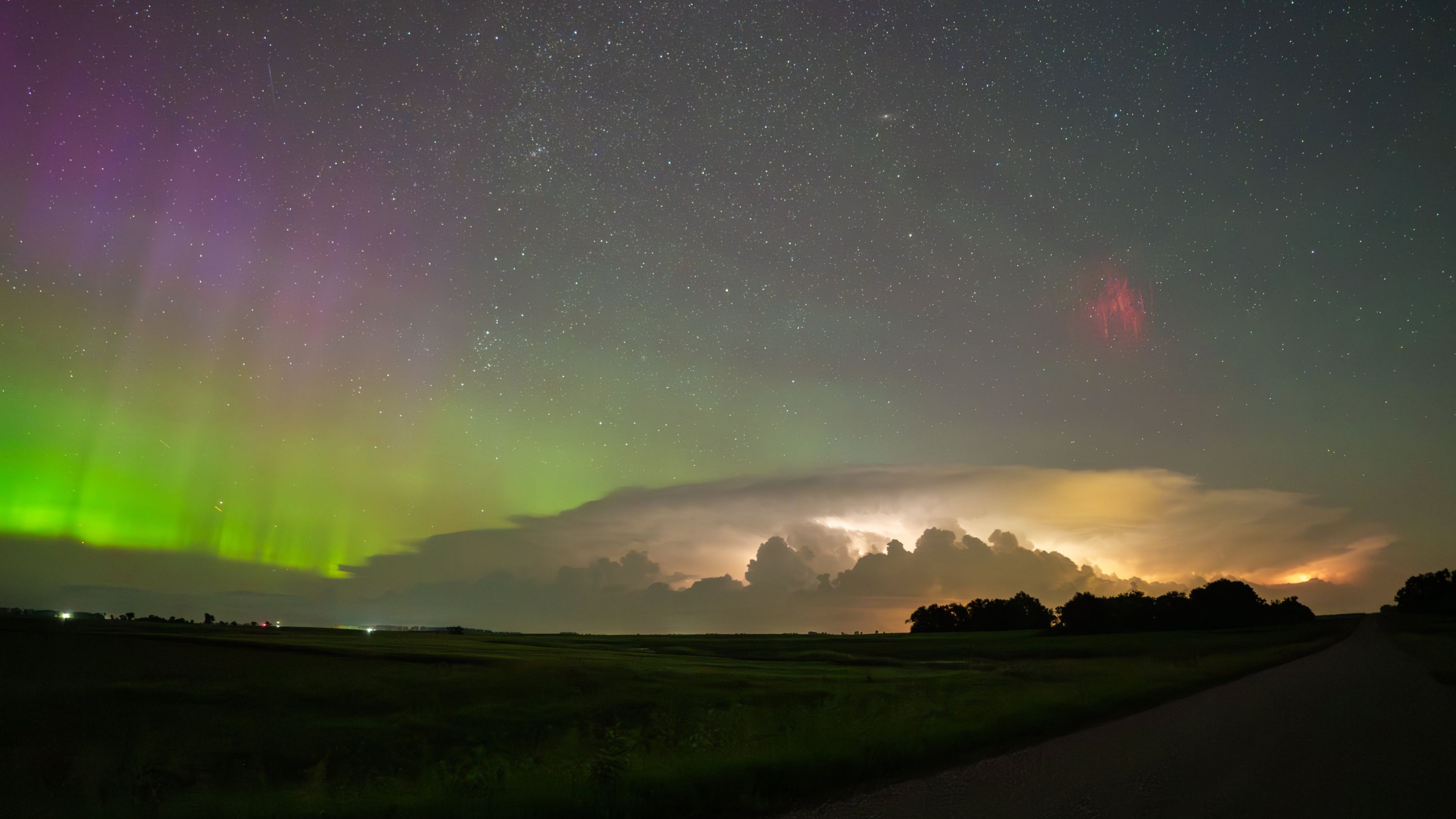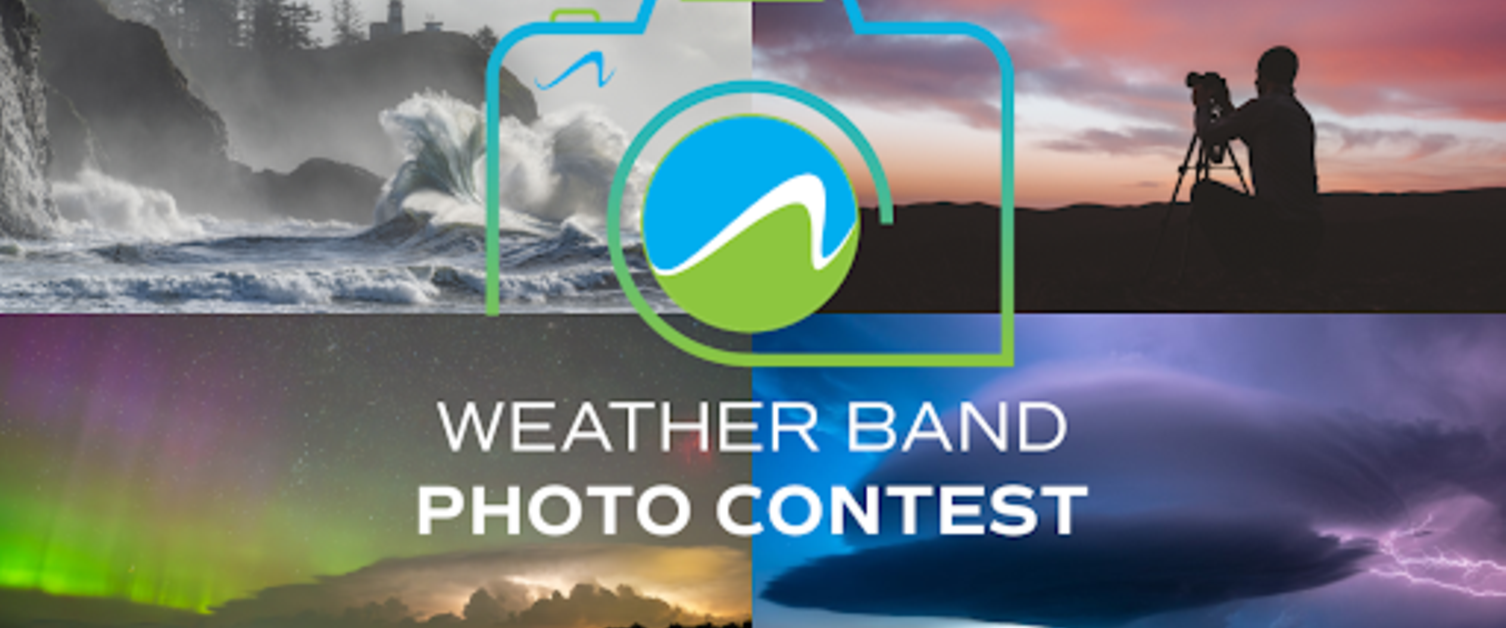Sprites, Splashes, and Storms: Photography Tips from our 2023 Photo Contest Winners
- By AMS Staff
- Aug 5, 2024
Sprites, Splashes, and Storms: Photography Tips from our 2023 Photo Contest Winners
The Weather Band Photo Contest attracts amazing photo submissions from all over the world. Earlier this year, we were lucky to hear advice from some of our 2023 contest winners—Kristy Sharkey (a UX designer and photographer who lives near Seattle), Elan Azriel (a North Dakota-based photographer and storm chaser), and Michael Seger (chief meteorologist at KJRH in Tulsa, OK)—in our “Weather Lens” webinar, moderated by Alan Sealls, retired TV chief meteorologist in Mobile, Alabama.
Are you getting into weather photography? Looking to submit something to our 2024 Photo Contest (open through August 30!)? Why not review some of their advice?
What makes an award-winning photo?
Michael: Having a good composition [in which] your eyes can flow through the photograph, and maybe a little bit of a story behind it, and having, on the other side of the camera, a passionate photographer.
Kristy: Composition is key. I think the photographer needs to have a point of view and that can be what makes a composition really unique. But ultimately, it really comes down to who’s consuming your photographs and what captures them.
Elan: Composition can make or break a photo … [but] luck is [also] a big aspect of it, especially when it comes to storm photography. You can chase the storm all you want and it might just not put down the tornado … or not put down that lightning where you want it. But then the next storm, the next day might do exactly that, you might get the golden shot.
Tell us about your award-winning shot!

“King Tide” by Kristy Sharkey won Third Prize in the Weather Band 2023 Photo Contest.
Kristy: This photo was taken in December of 2020 at Cape Disappointment on the Washington Coast during a King Tide event. The Washington Coast is wild and rugged and a few times per year during the winter months we get unusually large tides when the sun, moon, and earth align just right. This was my first time photographing the King Tides and although I went there with some idea of the settings I wanted to use, I also got lucky as it was unusually bright that day. I shot this photo on my Sony A7R III using a 24-105mm full frame lens at 105mm. I shot this at F11 because I wanted it to be sharp from front to back, at ISO 100 because it was actually bright that day (not always the case during Washington winters), and at a shutter speed of 1/640 seconds. Ideally the shutter speed would have been a bit closer to 1/1000 but thanks to the bright lighting and the sea mist it created a dreamy painterly effect.

“Night Lights” by Elan Azriel won the Grand Prize in the 2023 Weather Band Photo Contest.
Elan: Right now I’m shooting with a Sony a7 III … I do a lot of long-exposure stuff … ever since I moved out to North Dakota from Pennsylvania. … We have a lot of nighttime events here—thunderstorms, auroras, and just dark skies. It’s honestly really incredible to get to experience that here. …
Over on the right side [of the photo] is a sprite, which is already a really cool, incredibly rare event on its own, and then just at the same time this band of aurora had come south. I didn’t expect it to come south that night. I went out to shoot sprites and was setting up my camera and took a picture and saw a little green glow, and then over the course of an hour or two it kept getting progressively brighter and further south and more colorful. And then I finally got the shot with the sprite and it was just like, Bam! Look at that! It was so cool.
Elan on shooting sprites:
Sprites are classified in this group called transient luminous events, TLEs; they’re discharges from the top of thunderstorms … sometimes a hundred kilometers or higher. And there are tons of different kinds.
When it comes to [shooting] sprites, I like to stick with 5- to 15-second exposures. Because my camera can handle higher ISOs, I like to shoot around 3200 or a little bit higher, and you want a really shallow depth of field … Ultimately, using an F-stop of 2.8 or less is going to allow more light in and it will do you a lot better than just turning up your ISO, and that just depends on which lens you use. The shot that I took was with F2.8 … I really like the focal length of 20 to 50 mm; if you’re a little farther from the storm, 50 mm is really nice, you can get a little more detail. But 20 is really nice, for like, big, wide landscape shots like what I just did, and that was shot at 20. … For forecasting sprites, you’re looking for thunderstorm complexes.

“Walsh Mothership” by Michael Seger won the Member’s Choice award in the 2023 Weather Band Photo Contest.
Michael: This was taken last year, in southeast Colorado. ... You get these sculpted supercells, and the shapes they take, the structure they have, it’s just a beautiful sight to see, even though these can be rather destructive. This storm produced a 4” diameter hail in Springfield, Colorado [and] was tornado-warned but never did produce a tornado. …
This was probably my favorite storm of my chase-cation. … I shot this with a 14 mm Sigma art lens … the first lens I ever bought, when I got into photography. A wide-angle shot—the storm is much closer than it appears. And it was just a beautiful storm, slow moving so you could stop for a while and shoot it and then drive two or three miles [and] set up again. … The one thing I do regret about this photograph is I don’t have a good foreground image, but the storm is so beautiful itself, it thankfully makes up for that. …
I was shooting 4 second exposures, so I was able to capture some of the lightning.
What are precautions to take or things to watch out for when taking photos of weather and water?
Elan: I often go out with at least one other person, but if I do go alone, I always leave my car running. …In the wintertime [it’s] getting down to -10, -15 degrees [at night]; if you shut off your car and you’re in the middle of nowhere and you can’t start it back up, that’s some big trouble. I also don’t like to shoot in places that don’t have good cell service. It’s [usually] not worth the risk of being out there.
Michael: Chasing in eastern New Mexico a few years ago, a western diamondback rattlesnake happened to be right about where I was setting up; I thought it was kind of cool, but it is something that you have to really watch for, especially when you’re chasing storms and you’re stepping into these tall, grassy prairies, you don’t know where your foot’s going to go. Another night, in Iowa, I had set up by railroad tracks and it sounded like [the coyotes] were about 100 meters away. I shined a flashlight and couldn’t see anything, but they were really making a lot of noise. … Another one [was] that I made a mistake in kneeling in fire ants at night. My knee, it was not pretty.
Kristy: There are cases where I’ll set up my video camera to do time lapse and I’ll go sit in the car 30 yards away … I did that a few springs ago, and when I got back to the tripod, almost underneath the tripod was a snake. Fortunately … it wasn’t a venomous snake, [but] I am really cautious at night when I’m walking to make sure I’m not about to step on something like that.
Alan: I was [chasing] in Texas, end of the day, full rainbow. The sun was right on the horizon, the full 180-degree arc. I was on a dirt road, back field, got out to shoot the rainbow, and immediately the mosquitoes swarmed. I had never been in a mosquito swarm, but it was honestly so bad that I couldn’t reposition myself to get a good shot, so I had to just kind of [take an] awkward shot of the rainbow and I had to get right back in the car and leave. So, [when it comes to what to be aware of,] could be mosquitoes, could be snakes, could be people.
What are some surprising things you’ve learned about nature photography since starting out?
Kristy: I had to chase in Washington last year. Not ideal … but I got to know my state, I learned more about the weather patterns here. I failed a bunch, which was great, and I got a lightning bolt, which I was really excited about.
If it inspires you, it’s gonna probably inspire someone else. And if it doesn’t, then you enjoyed it, so it doesn’t matter. … Just enjoy the failure. You have to enjoy the process and it’s not really about the shot for me. … Figuring out why you’re doing photography is an important aspect of being a photographer. … I’ve lost entire shoots on storms and had rolling shutter issues with one of the biggest supercells and lightning producers I’ve ever seen so the lightning shots didn’t come out. And I was like, well, I enjoyed the moment.
Elan: You don’t have to just go out and chase supercells or something. There’s some cool stuff that can happen in your backyard. It’s a little trickier sometimes to compose some of that stuff … but if you do it right and get an interesting foreground and color grade … it can come out really, really cool. Don’t be afraid to use the environment that you have. … It gets you out of the house, gets you breathing fresh air … and no matter what, it just makes your day a little better. …
For me, there is a fine line between [a processed image and a manipulated image] … You look at the raw image, and the raw image is not what you see with your eyes. … Often it’s a lot duller. … I spend the time recalling my experience, not just how I physically saw it, but how I felt. I want to convey that energy, that story that’s so important. It lets you relive it. And then because of that whole process, every time you see that image, it makes you feel really good and it looks really appealing. That whole process of shooting and editing to make it look how you felt and saw it in the moment is really important, and no one ever told me that until I really got into it.
Michael: It’s not the gear as much as it is … luck, timing, location, persistence, sweat. … You’re going to have a lot of photos that are going to be terrible. … that’s just how it is. … If anybody’s interested in doing photography, be patient with yourself. … Every time I go on a storm chase, I hope I can get one photo that I can hang up on a wall; not necessarily does that happen, but that’s the goal I set for myself. …
You’ll meet a lot of awesome people that share an interest with you and it can really be a fun experience. If you have an interest in photography, don’t let it intimidate you. I had known nothing about it and now I’ve got two cameras.
